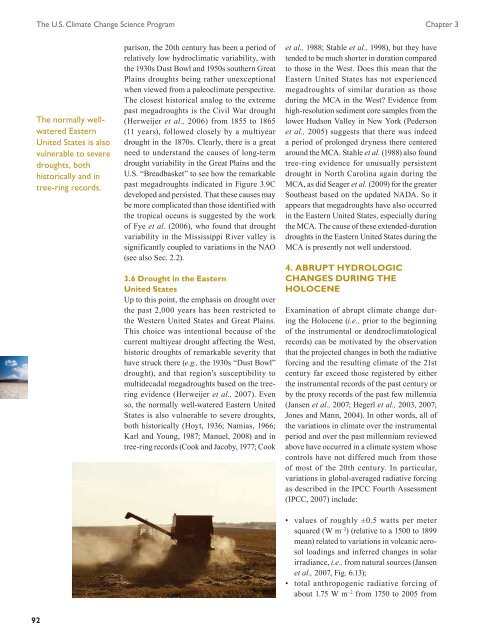Book 2.indb - US Climate Change Science Program
Book 2.indb - US Climate Change Science Program
Book 2.indb - US Climate Change Science Program
- No tags were found...
You also want an ePaper? Increase the reach of your titles
YUMPU automatically turns print PDFs into web optimized ePapers that Google loves.
The U.S. <strong>Climate</strong> <strong>Change</strong> <strong>Science</strong> <strong>Program</strong>Chapter 3The normally wellwateredEasternUnited States is alsovulnerable to severedroughts, bothhistorically and intree-ring records.parison, the 20th century has been a period ofrelatively low hydroclimatic variability, withthe 1930s Dust Bowl and 1950s southern GreatPlains droughts being rather unexceptionalwhen viewed from a paleoclimate perspective.The closest historical analog to the extremepast megadroughts is the Civil War drought(Herweijer et al., 2006) from 1855 to 1865(11 years), followed closely by a multiyeardrought in the 1870s. Clearly, there is a greatneed to understand the causes of long-termdrought variability in the Great Plains and theU.S. “Breadbasket” to see how the remarkablepast megadroughts indicated in Figure 3.9Cdeveloped and persisted. That these causes maybe more complicated than those identified withthe tropical oceans is suggested by the workof Fye et al. (2006), who found that droughtvariability in the Mississippi River valley issignificantly coupled to variations in the NAO(see also Sec. 2.2).3.6 Drought in the EasternUnited StatesUp to this point, the emphasis on drought overthe past 2,000 years has been restricted tothe Western United States and Great Plains.This choice was intentional because of thecurrent multiyear drought affecting the West,historic droughts of remarkable severity thathave struck there (e.g., the 1930s “Dust Bowl”drought), and that region’s susceptibility tomultidecadal megadroughts based on the treeringevidence (Herweijer et al., 2007). Evenso, the normally well-watered Eastern UnitedStates is also vulnerable to severe droughts,both historically (Hoyt, 1936; Namias, 1966;Karl and Young, 1987; Manuel, 2008) and intree-ring records (Cook and Jacoby, 1977; Cooket al., 1988; Stahle et al., 1998), but they havetended to be much shorter in duration comparedto those in the West. Does this mean that theEastern United States has not experiencedmegadroughts of similar duration as thoseduring the MCA in the West? Evidence fromhigh-resolution sediment core samples from thelower Hudson Valley in New York (Pedersonet al., 2005) suggests that there was indeeda period of prolonged dryness there centeredaround the MCA. Stahle et al. (1988) also foundtree-ring evidence for unusually persistentdrought in North Carolina again during theMCA, as did Seager et al. (2009) for the greaterSoutheast based on the updated NADA. So itappears that megadroughts have also occurredin the Eastern United States, especially duringthe MCA. The cause of these extended-durationdroughts in the Eastern United States during theMCA is presently not well understood.4. Abrupt Hydrologic<strong>Change</strong>s During theHoloceneExamination of abrupt climate change duringthe Holocene (i.e., prior to the beginningof the instrumental or dendroclimatologicalrecords) can be motivated by the observationthat the projected changes in both the radiativeforcing and the resulting climate of the 21stcentury far exceed those registered by eitherthe instrumental records of the past century orby the proxy records of the past few millennia(Jansen et al., 2007; Hegerl et al., 2003, 2007;Jones and Mann, 2004). In other words, all ofthe variations in climate over the instrumentalperiod and over the past millennium reviewedabove have occurred in a climate system whosecontrols have not differed much from thoseof most of the 20th century. In particular,variations in global-averaged radiative forcingas described in the IPCC Fourth Assessment(IPCC, 2007) include:• values of roughly ±0.5 watts per metersquared (W m –2 ) (relative to a 1500 to 1899mean) related to variations in volcanic aerosolloadings and inferred changes in solarirradiance, i.e., from natural sources (Jansenet al., 2007, Fig. 6.13);• total anthropogenic radiative forcing ofabout 1.75 W m –2 from 1750 to 2005 from92






